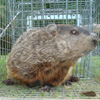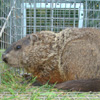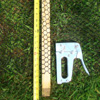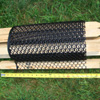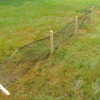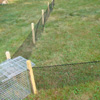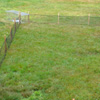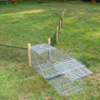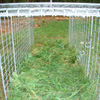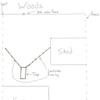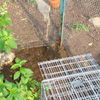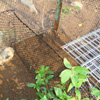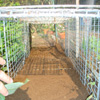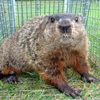How to trap Woodchucks
Starting around May 1st we get inundated with calls for woodchuck trapping. Every May these ferocious little vegetarians emerge from their winter hideouts to wreak havoc on vegetable gardens and other expensive landscaping. Homeowners that have spent weeks (if not months) working in their yards.
I get calls from people that are extremely upset about the damage that woodchucks have done and want an immediate solution to their woodchuck problem. The problem that we have is that this big surge in woodchuck calls coincides PERFECTLY with the big surge of raccoon, squirrel and bat calls that we get every spring. During the months of May and June we are so busy removing other animals that we simply do not have to time set and maintain 2 dozen woodchuck traps. Woodchuck trapping can be tricky and it takes a skillful trapper to consistently succeed in trapping them. I have a couple good woodchuck trappers that I refer people to in certain areas but for 80% of our service area I don't have anyone to refer. This has gone on for years. This year I made the decision to write this article to teach people how to trap woodchucks and put an end to their woodchuck dilemmas.
What about Woodchuck repellants?
The only effective solution to a woodchuck problem is trapping and removing the woodchucks from your property. Forget about woodchuck repellants, deterrents, mothballs and sprinkling coyote urine around the yard. These are foolish practices and will provide temporary relief if any at all. In order to solve a woodchuck problem for any amount of time they must be trapped and removed from your property.
Woodchuck Trapping Equipment
Below are the items that you will need to trap woodchucks in your yard. I strongly suggest you use exactly what is listed below. I have used these items for years and found them to work very well.
Woodchuck trap - A double door cage trap with a 12-16 inch opening works best for woodchucks. A trap with two doors with out-perform a single door trap 10 to 1 in most cases. Tomahawk makes a nice double door trap. You can order these from several different suppliers online.
10-20 Wooden Landscape Stakes - These stakes can be found at most hardware stores in the fence section. Home Depot and Lowes both carry them. Most will measure 1.5" square and be about 24 inches long.
Plastic Landscape Fencing - Once again you can find this material in the fencing section at Home Depot and Lowes. I prefer the flexible rubber material as it is much easier to work with. A 3 foot by 24 foot roll will be enough to get you started.
Tools - All you need is a hammer to pound the stakes into the ground and a staple gun to attach the plastic fence material to the stakes.
Assembly - Attach the fencing material to the landscaping stakes as shown in the pictures above. One landscaping stake every 4 feet or so is good..
Woodchuck Trapping Setup
The basic goal of this woodchuck trapping method is to funnel the woodchuck into the trap. Use your landscape fencing to create a funnel and place the trap at the narrow end of the funnel. You can make the landscape fencing as long or as short as you need. In some cases you may need to stretch it across your entire yard while in other cases you may only need short sections. You may also put fencing at both ends of the trap creating a double funnel which allows you to catch them traveling in both directions. See Trap Placement paragraph below for more info.
Cover the floor of the trap with a layer of grass. Make an effort to hide all of the metal on the floor of the trap. Woodchucks are very smart and will often avoid a trap if they can see the metal floor of the trap. Your goal is to make it appear natural, just like the rest of the grass in your yard.
One very important part of this method that must not be overlooked is DO NOT USE BAIT. Placing bait in the trap will only put the woodchuck on alert. Woodchucks love vegetable gardens. By setting this trap in the correct manner between the woodchuck's den and your vegetable garden you will be able to trap them without using bait.
Woodchuck Trap Placement
Setting up this trap in the correct area is the most critical part of the project. If you've studied your woodchuck you should have a pretty good idea where they come from in order to get to your garden. The ideal setup is to have this funnel/trap in between the woodchuck's den and your garden. Use your fencing or any natural funnels in your yard to make it so the woodchuck must pass through your funnel/trap to get to your garden (his food source).
The sketch below is supposed to be an overhead view of a backyard. Please excuse the crudeness of my drawing as I flunked art class.
With a trap setup in the manner shown above it is impossible for a woodchuck to get to the garden without having to pass through the trap. It may take a few days to trap the woodchuck with this setup but in the meantime he will not be able to get to your garden.
Trap setup for a Woodchuck digging under garden fence
A woodchuck digging under a garden fence is a situation that we see all the time. Woodchucks are very good at digging and can often dig several feet down into the ground in order to gain access to a delicious vegetable garden. In this situation a woodchuck is very vulnerable and somewhat easy to trap with the correct trap placement. You want to setup your trap so that when the woodchuck goes through the hole and into the garden he comes up inside of your trap. It's hard to explain but easy to do. See pictures below.
Use a piece of landscape fencing to box him in and funnel the woodchuck into the trap. You're making it so he has no other options but to go through your trap to gain access to the garden. Once again you want to cover the floor of the trap with dirt to hide the metal and make it appear natural. Just like the yard setup you DO NOT want to use bait in this situation. There is no need for it. Your garden is the bait.
Woodchuck Trapping Conclusion
Woodchuck trapping takes a little bit of effort to be successful. A crafty homeowner can use this guide to control the woodchuck population of their yard and protect their precious vegetables, flowers and other landscaping from these ferocious herbivores.
Matthew Grady
BatGuys Wildlife Service
Copyright 2009 BatGuys LLC. This article may not be reprinted without the consent of BatGuys LLC.
